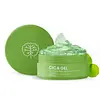What's inside
What's inside
 Key Ingredients
Key Ingredients

No key ingredients
 Benefits
Benefits

 Concerns
Concerns

No concerns
 Ingredients Side-by-side
Ingredients Side-by-side

Water
Skin ConditioningGlycerin
HumectantDicaprylyl Ether
EmollientDimethicone
EmollientDimethicone Crosspolymer
Emulsion StabilisingPolyacrylamide
C13-14 Isoparaffin
EmollientLaureth-7
EmulsifyingMethylsilanol Mannuronate
Skin ConditioningPhenoxyethanol
PreservativeEthylhexylglycerin
Skin ConditioningSilanetriol
Hyaluronic Acid
HumectantRetinyl Palmitate
Skin ConditioningHibiscus Sabdariffa Flower Extract
Skin ConditioningHippophae Rhamnoides Fruit Oil
Skin ProtectingOenothera Biennis Oil
EmollientMilk Lipids
Skin ConditioningCeramide NP
Skin ConditioningAcrylates/C10-30 Alkyl Acrylate Crosspolymer
Emulsion StabilisingTocopheryl Acetate
AntioxidantSodium Hydroxide
BufferingSodium Ascorbyl Phosphate
AntioxidantPanthenol
Skin ConditioningAllantoin
Skin ConditioningDisodium EDTA
CI 16185
Cosmetic ColorantCI 15985
Cosmetic ColorantCI 42090
Cosmetic ColorantWater, Glycerin, Dicaprylyl Ether, Dimethicone, Dimethicone Crosspolymer, Polyacrylamide, C13-14 Isoparaffin, Laureth-7, Methylsilanol Mannuronate, Phenoxyethanol, Ethylhexylglycerin, Silanetriol, Hyaluronic Acid, Retinyl Palmitate, Hibiscus Sabdariffa Flower Extract, Hippophae Rhamnoides Fruit Oil, Oenothera Biennis Oil, Milk Lipids, Ceramide NP, Acrylates/C10-30 Alkyl Acrylate Crosspolymer, Tocopheryl Acetate, Sodium Hydroxide, Sodium Ascorbyl Phosphate, Panthenol, Allantoin, Disodium EDTA, CI 16185, CI 15985, CI 42090
 Reviews
Reviews

Ingredients Explained
These ingredients are found in both products.
Ingredients higher up in an ingredient list are typically present in a larger amount.
Glycerin is already naturally found in your skin. It helps moisturize and protect your skin.
A study from 2016 found glycerin to be more effective as a humectant than AHAs and hyaluronic acid.
As a humectant, it helps the skin stay hydrated by pulling moisture to your skin. The low molecular weight of glycerin allows it to pull moisture into the deeper layers of your skin.
Hydrated skin improves your skin barrier; Your skin barrier helps protect against irritants and bacteria.
Glycerin has also been found to have antimicrobial and antiviral properties. Due to these properties, glycerin is often used in wound and burn treatments.
In cosmetics, glycerin is usually derived from plants such as soybean or palm. However, it can also be sourced from animals, such as tallow or animal fat.
This ingredient is organic, colorless, odorless, and non-toxic.
Glycerin is the name for this ingredient in American English. British English uses Glycerol/Glycerine.
Learn more about GlycerinPhenoxyethanol is a preservative that has germicide, antimicrobial, and aromatic properties. Studies show that phenoxyethanol can prevent microbial growth. By itself, it has a scent that is similar to that of a rose.
It's often used in formulations along with Caprylyl Glycol to preserve the shelf life of products.